This BAMS special report presents assessments of how human-caused climate change may have affected the strength and likelihood of individual extreme events.
In any given year you can find extremes of all kinds. Anthropogenic Climate Change is usually attributed as the reason for the events, with metal gymnastics employed. All extremes - heat and cold, wet and dry, more hurricanes, fewer hurricanes , more tornadoes, fewer tornadoes, more snow, less snow, more Ice, less ice, slower sea level rise/ larger sea level rises are all attributed to CO2 warming. It is a non falsifiable hypothesis.
We assembled true climate experts in each extreme weather phenomena and they have objectively looked at US extremes attributed to man here - you see the claims can be explained by natural factors or when man is involved, it is related to bad policies based on failing theories. Please help support our efforts to keep this up to date (DONATE BUTTON is on the left column. The work has been done by all pro bono. Rest assured the cash flow on the alarmist side is constant and abundant. Sadly most all energy companies, the auto companies, manufacturing and most industries have all prematurely thrown in the towel on this issue. We will all pay the price later on unless we can turn opinion around by getting the truth out.
The models are failing as John Christy explained in this WUWT story by David Middleton.
This is a full transcript of a talk given by Dr John Christy to the GWPF on Wednesday 8th May.
When I grew up in the world of science, science was understood as a method of finding information. You would make a claim or a hypothesis, and then test that claim against independent data. If it failed, you rejected your claim and you went back and started over again. What I’ve found today is that if someone makes a claim about the climate, and someone like me falsifies that claim, rather than rejecting it, that person tends to just yell louder that their claim is right. They don’t look at what the contrary information might say.
OK, so what are we talking about? We’re talking about how the climate responds to the emission of additional greenhouse gases caused by our combustion of fossil fuels.
[....]
So here’s the deal. We have a change in temperature from the deep atmosphere over 37.5 years, we know how much forcing there was upon the atmosphere, so we can relate these two with this little ratio, and multiply it by the ratio of the 2x CO2 forcing. So the transient climate response is to say, what will the temperature be like if you double CO2 - if you increase at 1% per year, which is roughly what the whole greenhouse effect is, and which is achieved in about 70 years. Our result is that the transient climate response in the troposphere is 1.1 C. Not a very alarming number at all for a doubling of CO2. When we performed the same calculation using the climate models, the number was 2.31C. Clearly, and significantly different. The models’ response to the forcing [- their delta T here, was over 2 times greater than what has happened in the real world.
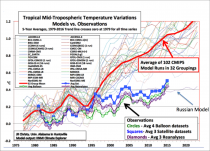
(note the actual temperature profile matches the non greenhouse gas model profile)
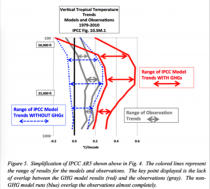
[...]
There is one model that’s not too bad, it’s the Russian model. You don’t go to the White House today and say, “the Russian model works best”. You don’t say that at all! But the fact is they have a very low sensitivity to their climate model. When you look at the Russian model integrated out to 2100, you don’t see anything to get worried about. When you look at 120 years out from 1980, we already have 1/3 of the period done - if you’re looking out to 2100. These models are already falsified, you can’t trust them out to 2100, no way in the world would a legitimate scientist do that. If an engineer built an aeroplane and said it could fly 600 miles and the thing ran out of fuel at 200 and crashed, he might say: “I was only off by a factor of three”. No, we don’t do that in engineering and real science! A factor of three is huge in the energy balance system. Yet that’s what we see in the climate models.
I have three conclusions for my talk:
Theoretical climate modelling is deficient for describing past variations. Climate models fail for past variations, where we already know the answer. They’ve failed hypothesis tests and that means they’re highly questionable for giving us accurate information about how the relatively tiny forcing, and that’s that little guy right there, will affect the climate of the future.
The weather we really care about isn’t changing, and Mother Nature has many ways on her own to cause her climate to experience considerable variations in cycles. If you think about how many degrees of freedom are in the climate system, what a chaotic nonlinear, dynamical system can do with all those degrees of freedom, you will always have record highs, record lows, tremendous storms and so on. That’s the way that system is.
And lastly, carbon is the world’s dominant source of energy today, because it is affordable and directly leads to poverty eradication as well as the lengthening and quality enhancement of human life. Because of these massive benefits, usage is rising around the world, despite calls for its limitation.
And with that I thank you very much for having me.
GWPF
Note it has been shown the greenhouse models share a common element - a tropical hotspot at 30-40,000 feet seen in the model but not in the satellite or balloon data. Nor is there any warming seen in the oceans beneath.
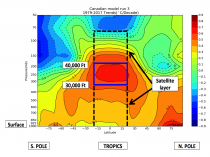
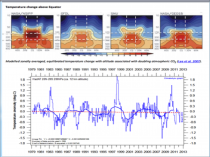
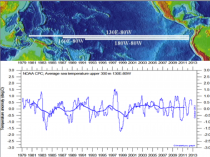
Icecap Note; 10 years ago, CLIMATEGATE exposed the scandalous behavior of the world’s scientists with respect to the global warming eco-fantasy. Like with so many other political driven issues it was largely ignored by the media with the hope the public would not rise up against it. Marc Morano in The Politically Incorrect Guide to Climate Change, The Politically Incorrect Guide to Climate Change summarized all the emails and the scientists. Here is the Chapter 10 excerpt on Climategate.
By Tony Thomas, Quadrant
It’s the tenth anniversary next week of the 2009 Climategate email dump that exposed top climate scientists’ chicanery and subversion of science - and did so in their own words and out of their own mouths, or keyboards. I’ll list a few emails-of-infamy shortly, but first some background.
For the three years before Climategate, the climate crowd was ascendant with its pseudo-narrative of “settled science”. Al Gore’s error-riddled propaganda movie Inconvenient Truth of 2006 had swept the Western world and its readily-traduced schoolkids. In 2007 Gore and the Intergovernmental Panel on Climate Change shared the Nobel Peace Prize. In late 2008 Barack Obama won the White House, proclaiming in his modest way, “This was the moment when the rise of the oceans began to slow and our planet began to heal.”
The Climategate emails hit the blogosphere just a month before the Copenhagen summit was scheduled to lock Western countries into Kyoto Mark 2, a legally-binding commitment to renewables from 2012. Climategate destroyed warmists’ moral high ground and reinforced the natural reluctance of most governments to up-end their economies with emission controls. The Copenhagen circus fell apart, resolving merely to “take note” of the exhortations to action by Obama and like-minded leaders.
The mainstream media strove to ignore and bury the Climategate revelations. The climate establishment ran half a dozen inquiries with limited briefs and ludicrous lack of rigour, all of which purported to clear the climate scientists of wrong-doing.[1] But even today, ten years after, scientists faithful to their calling and disciplines can only shudder at what Climategate revealed. Those who subverted the scientific method were not fringe players but at the pinnacle. They were doing the archetypal studies “proving” catastrophic human-caused catastrophic warming (CAGW) and shaping the content and messaging in the six-yearly reports of the IPCC.
The hacked (or otherwise revealed) email archive spanning the prior decade was stored by the University of East Anglia’s Climatic Research Unit[2]. The CRU co-compiled the HadCRUT global temperature series, along with the UK Met Office’s Hadley Centre. This data set charting alleged global warming in fractions of a degree was a key input to the climate computer models forecasting doomladen heat for this century. (The model forecasts continue to exceed actual measured warming). Based on these dud modelled forecasts, the West is now spending $US 1.5 trillion a year in quest of zero CO2 emissions.
Today, anyone questioning this colossal enterprise is told to “respect the science”. Based on the Climategate emails released in 2009, 2013 and 2015, I’d rather respect the Mafia, who at least don’t claim to be saving the planet. For example, today we’re told that warming of 2 deg C above pre-industrial level is some sort of a tipping point of doom. Phil Jones, Director of the Climatic Research Unit, emailed on September 6, 2007, that the supposed 2-degree limit was “plucked out of thin air”, a throwaway line in an early 1990s paper from the catastrophists at the Potsdam Climate Impacts Institute.
Now for the emails. We journos love a local angle, and here’s one - the CRU’s Ian “Harry” Harris worked for four years to de-bug and properly document a CRU data base “TS 2.1” of global stations recording monthly temperatures.
One input was from the Australian Bureau of Meteorology, with its frequent adjustments that result in a greater warming trend (think Rutherglen and Darwin). Harry’s comments in a 200-page logging of notes:
What a bloody mess. Now looking at the dates..something bad has happened, hasn’t it. COBAR AIRPORT AWS [data from an Australian weather station] cannot start in 1962, it didn’t open until 1993!… getting seriously fed up with the state of the Australian data. So many new stations have been introduced, so many false references… so many changes that aren’t documented.. I am very sorry to report that the rest of the databases seem to be in nearly as poor a state as Australia was...Aarrggghhh! There truly is no end in sight...!
What else did Harry Harris mention? Perhaps science-respecting Dr Ross Garnaut (Q&Aon November 11) could get his head around this lot (emphasis added):
OH F**K THIS. It’s Sunday evening, I’ve worked all weekend, and just when I thought it was done I’m hitting yet another problem that’s based on the hopeless state of our databases ....Bear in mind that there is no working synthetic method for cloud, because Mark New lost the coefficients file and never found it again (despite searching on tape archives at UEA) and never recreated it ... This whole project is SUCH A MESS. No wonder I needed therapy!!… So, uhhhh what in tarnation is going on? Just how off-beam are these datasets?!! ....Unbelievable - even here the conventions have not been followed. It’s botch after botch after botch...Where is the documentation to explain all this?! ... It’s halfway through April and I’m still working on it. This surely is the worst project I’ve ever attempted. Eeeek...Oh bugger. What the HELL is going on?!… Oh GOD if I could start this project again and actually argue the case for junking the inherited program suite!! ... Am I the first person to attempt to get the CRU databases in working order?!! ... So, we can have a proper result, but only by including a load of garbage…
Who added those two series together? When? Why? Untraceable, except anecdotally. It’s the same story for many other Russian stations, unfortunately - meaning that (probably) there was a full Russian update that did no data integrity checking at all. I just hope it’s restricted to Russia!! ...What the hell is supposed to happen here? Oh yeah - there is no ‘supposed’, I can make it up. So I have ... [My attempted corrections] will allow bad databases to pass unnoticed, and good databases to become bad, but I really don’t think people care enough to fix ‘em, and it’s the main reason the project is nearly a year late.”
That was then. How’s things today?
In 2015 Prime Minister Tony Abbott set in train an audit of Australia’s Bureau of Meteorology’s temperature adjustments that increased Australia’s apparent warming, but one of the first moves of his successor, Malcolm Turnbull, was to scuttle that audit. Of equal significance is that late last year, Melbourne scientist Dr John McLean published the first-ever audit of Britain’s HADCRUT4 temperature data set and commented,
It’s very careless and amateur. About the standard of a first-year university student...Governments have had 25 years to check the data on which they’ve been spending billions of dollars. And they haven’t done so once.
For example, he found that for two years the temperatures over land in the Southern Hemisphere were derived from just one site in Indonesia, and on two occasions the average December temperature at an airport on tropical St Kitts in the Caribbean was reported at zero degrees. The inaccuracies in the data record are so bad, McLean believes, that it is impossible to know how much global temperatures have really risen - probably about 0.4 deg C in 70 years, not the 0.6 deg C claimed.
Subverting peer review
Climategate showed how warmist scientists gamed the peer review process to ensure a monopoly for their views. When two papers contrary to their ‘consensus’ were published, CRU director Phil Jones and his circle pulled out all stops to get the editor sacked and prevent such papers being considered by the IPCC. Jones, 8 July 2004:
...I can’t see either of these papers being in the next IPCC report. Kevin [Trenberth, leading climate scientist] and I will keep them out somehow, even if we have to redefine what the peer-review literature is!
US colleague Dr Michael Mann (author of the influential-but-wrong Hockey Stick graph of the past 1000 years’ temperature), July 3, 2003:
It seems clear we have to go above [the sceptic author Chris de Freitas] ... I think that the community should, as Mike H [warmist scientist] has previously suggested in this eventuality, terminate its involvement with this journal at all levels - reviewing, editing, and submitting, and leave it to wither way into oblivion and disrepute.
(De Freitas at the University of Auckland served as deputy dean of science, head of science and technology, and for four years as pro vice-chancellor. He also served as vice-president of the Meteorological Society of New Zealand)
Concerning another sceptic scientist, Steve McIntyre (who used his superior statistical skills to refute Mann’s work), Mann wrote, in August 2007,
I have been talking [with] folks in the States about finding an investigative journalist to investigate and expose [him].
Restricting and adjusting data
CRU director Jones destroyed emails subject to Freedom of Information requests and urged colleagues to do the same. Some of the emails could have exposed improper manipulation of IPCC processes. In 2004 Jones refused a sceptic;s request for his source data:
...We have 25 or so years invested in the work. Why should I make the data available to you, when your aim is to try to find something wrong with it?
He had good reason to conceal his data. Perhaps here’s why:
# Jones, April 15, 2009: For much of the SH [Southern Hemisphere] between 40 and 60 [degrees] S[outh] the normals are mostly made up as there is very little ship data there.
# Jones, November 10, 2009: For the 1940-1960 period if the SSTs [sea surface temperatures] were adjusted they would look much better
# Scientist Dr Tom Wigley, then with the US Government, to Jones September 28, 2008, urging more adjusting: ...If you look at the attached plot you will see that the land also shows the 1940s warming blip. So, if we could reduce the ocean blip by, say 0.15 deg C, then this would be significant for the global mean- but we’d still have to explain the land blip....It would be good to remove at least part of the 1940s blip, but we are still left with ‘why the blip’.
# From Jones’ CRU colleague Dr Tim Osborn, December 20, 2006: Also we have applied a completely artificial adjustment to the data after 1960, so they look closer to observed temperatures than the tree-ring data actually were…
# Jones in November 2007 mentioned research malpractice allegations against some climate people in the US and Europe...I reckon only a few in the climate field know the full extent of what is going on behind the scenes in climate science. The Nobel Peace prize will certainly help, but some skeptics are redoubling their efforts.
# Jones’s University of East Anglia colleague Anthony Footitt, June 25, 2009: I do hope all these emails are just staying within UEA because it really makes us - UEA as a whole ‘ look like a bunch of amateurs.
Hiding the decline
On November 16, 1999, Jones welcomed and had re-used professionally a “trick” in a Nature article involving secret switching from tree-ring proxy temperature data to actual data. This covered up that tree-rings ceased to suggest rising temperature after 1960. That would have invalidated Mann’s tree-ring-based temperature chronologies for earlier centuries.
Jones: I’ve just completed Mike’s [Mann] Nature trick of adding in the real temps to each series for the last 20 years (i.e. from 1981 onwards) and from 1961 for Keith’s [Briffa] to hide the decline.
Scientist Tom Wigley points out flaws in Mann’s own research:
Mike, The Figure you sent is very deceptive ... there have been a number of dishonest presentations of model results by individual authors and by IPCC.
UK climate researcher Douglas Maraun:
How should we deal with flaws inside the climate community? I think that ‘our’ reaction on the errors found in Mike Mann’s work were not especially honest.
The IPCC exposed
UK Met Bureau’s Peter Thorne, concerning work on the IPCC’s 2007 fourth report:
I also think the science is being manipulated to put a political spin on it which for all our sakes might not be too clever in the long run.
Jones admits the political bias in the IPCC’s all-important Summary for Policy Makers (SPM):
He says he’ll read the IPCC Chapters! He hadn’t as he said he thought they were politically biased. I assured him they were not. The SPM [Summary for Policy Makers] may be, but not the chapters.
IPCC coordinating lead author Jonathan Overpeck:
The trick may be to decide on the main message and use that to guide what’s included and what is left out [of IPCC reports].
Need it be said that leaving out inconvenient stuff is anathema to real, genuine, principled science?
Warmist Mike Hulme agrees that
“the debate around climate change is fundamentally about power and politics rather than the environment ... There are not that many ‘facts about (the meaning of) climate change which science can unequivocally reveal”
From climate scientist Giorgi Filippo, who contributed to all five IPCC Assessment Reports:
I feel rather uncomfortable about using not only unpublished but also un- reviewed material as the backbone of our conclusions (or any conclusions)...I feel that at this point there are very little rules and almost anything goes
Email 5286 from scientist Hans von Storch:
“We should explain why we don’t think the information robust yet. Climate research has become a postnormal science, with the intrusion of political demands and significant influence by activists driven by ideological (well meant) concerns.”
Also from von Storch:
The concealment of dissent and uncertainty in favor of a politically good cause takes its toll on credibility, for the public is more intelligent than is usually assumed
Scientist Richard Somerville, 2004:
We don’t understand cloud feedbacks. We don’t understand air-sea interactions. We don’t understand aerosol indirect effects. The list is long.
Warmist Kevin Trenberth:
We are nowhere close to knowing where energy is going or whether clouds are changing to make the planet brighter
Michael Mann, 2006:
We certainly don’t know the GLOBAL mean temperature anomaly very well, and nobody has ever claimed we do.
Jones’ CRU was meant to provide part of the gold-standard science in the IPCC reports. Sadly, it lost or destroyed massive raw data from global temperature stations, admitting on its website in 2011, “We, therefore, do not hold the original raw data but only the value-added (i.e. quality controlled and homogenized) data.”
Warmist Keith Briffa:
It seems we got the balance between realism and hype about right
In light of all the above admissions of lost data, mangled data, twisted data and the stated intentions of the Climategate correspondents to produce work that confirmed warmist preconceptions, there is a delicious irony to the lament of Phil Jones in 2008
Why can’t people just accept that the IPCC is right!!
Miscellaneous mayhem
# University of East Anglia’s Mike Hulme: I am increasingly unconvinced by the majority of climate impact studies - including some of those I am involved in.
# Michael Mann: It would be nice to try to ‘contain’ the putative ‘Medieval Warming Period’. His Hockey Stick did just that. The medieval warming remains an embarrassment to climate scientists, since it is natural rather than CO2-related.
# Milind Kandlikar, 2004: Tuning [of models] may be a way to fudge the physics.
In November 2007: UN secretary-general Ban Ki Moon, perhaps actually believing what he was saying on the strength of the guff being fed to him, suggested CO2 might cause sea levels to rise six meters in 10 years - that is, by 2017!
Needless to say, universities have showered climate guys with honors. IPCC author Ben Santer agreed with honors for Jones and Wigley: “Phil Jones is one of the true gentlemen of our field” and the pair “deserve medals as big as soup plates”, he wrote, October 8, 2009.
After Climategate
Climategate’s influence on the public debate was fleeting. But now groups like Tim Flannery’s Climate Council persuade many citizens that any weather drama or fire is proof of global warming.[3] A steady stream of younger scientists, fuelled by propaganda from their earliest years in high school and locked onto their career rewards at “woke” universities for adhering to the warmist party line, is continuing the tradition of shoddy climate scholarship. Meanwhile, non-conformers like reef expert Peter Ridd get sacked.
Call me an optimist, but I see warming extremists alienating voters with a panoply of far-left “social justice” issues attached to their climate narrative - causes that make Greenpeace seem traditionalist.
The debate about the many interpretations of the science has become esoteric compared with close-to-home arguments about fossil-fuel power versus renewables. While Climategate exposed dud science, ten years later the hot topic is the exposure of unfeasible electricity makeovers.
Tony Thomas’s hilarious history, The West: An insider’s tale - A romping reporter in Perth’s innocent ‘60s is available from Boffins Books, Perth, the Royal WA Historical Society (Nedlands) and online here
[1] “The inquiries were largely unable to deal with the issue of the issue of blocking publication of papers, or intimidating journals. But academics reading the emails could see quite clearly the tribalism at work, and in comparison to other fields, climatology comes off looking juvenile, corrupt and in the grip of a handful of self-appointed gatekeepers and bullies.”
[2] The still-unidentified Climategate “hacker” said his motive was to help divert useless trillions for renewables towards doing genuine good for the world’s poor.
[3] Warmist scientist Steve Schneider perceptively said: “A mega heat wave this summer is worth 3 orders of magnitude more in the PR wars - too bad we have to wait for random events since evidence doesn’t seem to cut it anymore with the MSM [mainstream media].”
Redundancies at Enercon, the ongoing saga of the Senvion bankruptcy, and growing unease within the wind industry itself at the extremely low power prices being contracted, suggest that in desperate efforts to maintain a lucrative market position the sector has put itself in danger.
Presumptious Maid! with looks intent
Again she stretched, again she bent,
Nor knew the gulf between.
(Malignant Fate sat by, and smiled.)
The slippery verge her feet beguiled
She tumbled headlong in.
(Thomas Gray, “On a Favourite Cat, Drowned in a Tub of Gold Fishes")
Eddie O’Connor, the founder of Airtricity and Mainstream Renewable Power, is one of the most notable entrepreneurs in the wind industry and is consequently regarded with awe. His personal success speaks for itself, and if he chances to add anything further, obiter dicta, people pay attention. Speaking at the Reuters Offshore and Floating Wind Europe 2019, which was held in London on the 11th and 12th of November this year, Mr O’Connor seems to have dropped a bombshell. Reports claim that he shocked his audience by describing the wind sector as “on its knees” and in a state of “failure”, because “cut-throat” competition has driven contracted power prices to levels so low that wind is no longer “profitable”.
No objective observer will disagree that the wind industry overall appears to be struggling. Enercon, the Mercedes Benz of turbine makers, has just announced 3,000 redundancies in its home town of Magdeburg, and admitted to a $220m loss in 2018, with worse to come in 2019 ("Thousands to lose jobs as German wind crisis hits Enercon” 11.11.2019).
Indeed, in a measure quite incredible for a flagship German firm, Enercon has explained that it can no longer afford to make wind turbine blades in Germany, and will perforce attempt to preserve its viability by manufacturing overseas, presumably in locations where lower energy costs mean that labour is much cheaper.
Senvion, another troubled German manufacturer of wind turbines, entered into self-administered bankruptcy/liquidation in April, but has subsequently struggled to deliver reassuring news to the markets. On the 1st of November, and in the light of the fact that Senvion had not provided financial reports since beginning of the year, Moodys withdrew all its ratings from both Senvion S.A. and its subsidiary Senvion Holding GmbH, adding that it “continues to expect a meaningful loss to the current noteholders”.
It is clear that the problems summarised in an earlier Energy Comment post for this blog, “Is the Long Renewables Honeymoon Over” (11.05.19), are very far from diminishing and indeed seem to be growing still more serious.
Cutting through this miscellany of industry difficulties Mr O’Connor went straight to the heart of the matter, profitability, with his emphasis on contracted power prices. As is notorious, there has been a strong tendency in recent years for the wind sector in general to justify earlier generous subsidies on the grounds that costs had, as a result now fallen. Offshore wind projects, for example, are claiming dramatic (and implausible) capital cost reductions, backing up such claims by signing contracts to supply electricity at surprisingly low prices, even at so-called Zero-Subsidy levels. In the UK the latest instance of this is the Round 3 Allocation of Contracts for Difference, which announced strike prices of 40 pounds/MWh for about 4.5 GW of capacity at five gigantic projects. This appears to be below the likely wholesale price, let alone below the fundamental price needed to deliver a return on investment for the wind farms themselves.
Mr O’Connor clearly has a point, and though he did not add that Hughes, Aris, and Constable were right in their study for GWPF in 2017, Offshore Wind Strike Prices: Behind the Headlines, his remarks are consistent with the view that those authors took, namely that the CfDs issued in that year were at unrealistically low levels and could only be understood either as mistakes, which seems unlikely, or more probably as complicated options and high risk gambling, a view that Professor Hughes has developed in a subsequent paper for GWPF (Who’s the Patsy? Offshore wind’s high-stakes poker game).
Nevertheless, the logic of the wind industry’s public relations agenda forces it to maintain its position and indeed to go beyond it. Bizarre though it may seem, analysts close to the industry such as DNV GL are now suggesting that future contract bids will be negative, in other words that wind power developers will actually be willing to pay for contracts in order to secure the option for development (When Will European Offshore Wind See Negative Bids?).
But such tactics are clearly hazardous. Andrei Utkin of IHS Markit is quoted in the same source as sounding a warning note:
In a way, when we compare the French and U.K. winning bid levels with forward prices, we already see negative bids: forward baseload prices for year-ahead delivery are above those levels. [...] More and more renewables coming onto the grid will result in more curtailment and lower wholesale power prices. (...) As a result, the price that renewables will be able to capture in the market will decrease as well, going below their levelized cost of energy and potentially triggering the need for government support.”
Quite. But can the industry survive the transition period to renewed subsidy and will that subsidy actually be forthcoming? Mr O’Connor’s instincts, and he must have excellent instincts for such things, are that the industry’s position is perilous. Wind power may well be in desperate need, on its knees in fact, but sympathy is likely to be in short supply:
Eight times emerging from the flood
She mewed to every watery god,
Some speedy aid to send
No Dolphin came, no Nereid stirred;
Nor cruel Tom, nor Susan heard.
A Favourite has no friend!
Dr John Constable: GWPF Energy Editor.


